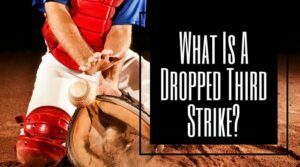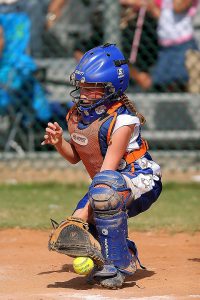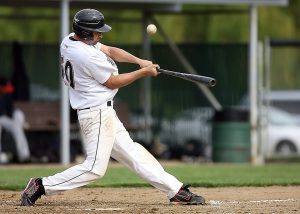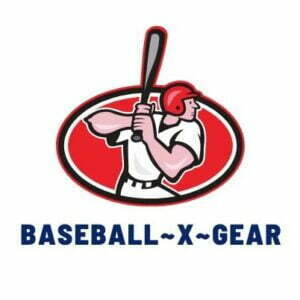I have a question for you! What is a dropped third strike in baseball?
Howdy friends and welcome back to BaseballXGear!
Today we will be discussing a play that can happen during a baseball game that can leave some fans wondering what the heck just happened.
It’s called the dropped third strike, and if you’re not familiar with baseball rules, it can most certainly be a little confusing.
While it may not be something that happens too often during a professional baseball game, it is quite common at the Little League level.
A dropped third strike at the college and professional level in softball is the same as in baseball.
Let’s get started and answer the question – What is a dropped third strike in baseball?
What Is A Dropped Third Strike In Baseball?
I like to think of a dropped third strike as a last chance for a batter who has struck out during an at bat to try and reach base safely.
If the catcher is unable to catch the pitched ball cleanly, and it is the third strike of the at bat, then the batter can attempt to run to first base.
If the runner reaches first base before the ball, or before being tagged by the ball, then they will be safe.
Next up, we will take a look at the conditions that must be present for the dropped third strike rule to come into play.
Conditions That Must Be Present For The Dropped Third Strike Rule
There are certain conditions that need to be present during the game before a batter can try to reach first base due to a dropped third strike.
- First base is not already occupied by a runner
- There are already 2 outs in the inning
Now to clarify a little further.
If first base is unoccupied, then the batter can try to run to first base regardless of how many outs there are in the inning.
If there are already 2 outs in the inning, then the batter can try to run to first base on a dropped third strike, regardless of whether or not first base is already occupied.
Make sense?
If not, fear not!
Next up we will go through a few scenarios where a batter can and cannot attempt to run to first base on a dropped third strike.
What Is A Dropped Third Strike In Baseball? – Scenarios
Let’s take a look at some dropped third strike scenarios and see if you can determine whether or not the batter can attempt to run to first base.
Dropped Third Strike Scenario 1
Let’s say that the first 2 batters of the inning have reached base safely and currently occupy first and second base. There are no outs in the inning.
Our batter steps to the plate and watches 2 perfectly good fastballs go by without swinging. The count is now 0-2 (no balls and 2 strikes.)
The pitcher decides to change things up and throw a curve ball.
The batter is caught off guard and swings and misses, but the ball bounces in the dirt and the catcher is unable to catch the ball.
Since it is a dropped third strike, can the batter attempt to run to first?
If you answered no, then you are correct.
Even though the catcher was unable to catch the pitch cleanly, the batter is not able to try and reach first base because first base was already occupied and there were less than 2 outs.
Dropped Third Strike Scenario 2
Let’s say the first batter of the inning hits a line drive to right field.
The ball rolls all the way to the the fence and the right fielder is having a hard time getting to the ball.
The batter sees the ball go all the way to the fence and turns on the jets and reaches third base safely for a stand up triple!
Our batter steps to the plate with a runner already on third base and no outs in the inning.
Our batter works the count full (3 -2, 3 balls and 2 strikes) when the the pitcher throws up a nasty knuckle ball.
The batter swings desperately, but is unable to hit the pitch.
The catcher manages to get his glove on it, but the ball drops out and hits the ground.
Since this is a dropped third strike, will the batter be able to try and run to first base?
If you answered yes, then you are correct!
Regardless of how many outs there were, since first base was not occupied by a base runner, the batter can attempt to run to first base on a dropped third strike.
Dropped Third Strike Scenario 3
In this scenario, our first 2 batters of the inning have struck out.
After a great start to the inning, the pitcher really starts to struggle and walks the next 3 batters.
There are 2 outs with the bases loaded when our batter steps to the plate.
The pitcher recovers and throws 2 fastballs for strikes.
With an 0 -2 count, our batter is forced to swing at anything close to the strike zone.
The pitcher throws up a wild curve ball that hits the dirt before the catcher can catch it.
Our batter, in a desperate attempt to not strike out with the bases loaded, swings at the pitch anyway, but is unable to make contact.
Since this is a dropped third strike, can the batter attempt to reach first base?
If you answered yes, then you are correct!
Since there were already 2 outs in the inning, it does not matter that first base was already occupied by a runner.
Make better sense now?
Awesome!
Let’s wrap things up.
What Is A Dropped Third Strike In Baseball? – That’s A Wrap!
The dropped third strike rule in baseball can be a little confusing, but now that you are an expert, you will now know how to explain it to someone who may not know.
The next time you see a batter strike out and then take off running like a bat out of hell, you will know exactly what’s going on. 🙂
Just remember the conditions that are in play when the batter is up.
If first base is not occupied, or if there are 2 outs in the inning, then a batter can try to run to first base on a dropped third strike.
Think of it like this:
First base occupied with less than 2 outs, batter cannot attempt to run to first base on a dropped third strike.
First base not occupied, batter can attempt to run to first base, regardless of how many outs there are in the inning.
Before we go, I would like to clear up one more confusing aspect of the dropped third strike.
A dropped third strike doesn’t necessarily mean that the catcher caught the ball and then dropped it.
If the pitch hits the ground before reaching the catcher and it is the third strike, it is automatically considered a dropped third strike.
A pitch that hits the ground before reaching the catcher is considered uncatchable and if all the conditions we talked about are present, then the runner would be able to try and reach first base.
This will of course assume that the batter tried to swing at the pitch and missed.
Swinging and missing at a good curve ball in the dirt is most likely when you will see a dropped third strike at the professional level of baseball.
Well…We did it!
You are now an expert about baseball’s dropped third strike rule.
The next time you hear someone ask, what is a dropped third strike in baseball?… You got this!
I hoped that you enjoyed this article and that we answered the question…What is a dropped third strike in baseball?
If you have any other questions about the dropped third strike rule, or anything else, please leave a comment below and I will get back with you as soon as possible.
You can also use the contact button in the sidebar to send me a direct e mail.
Thanks for stopping by ~Jeremy
